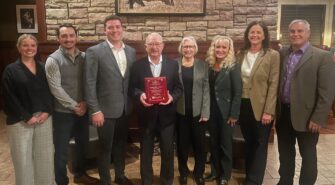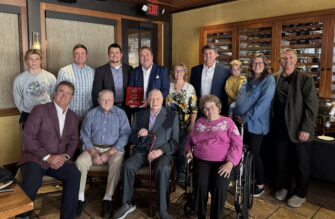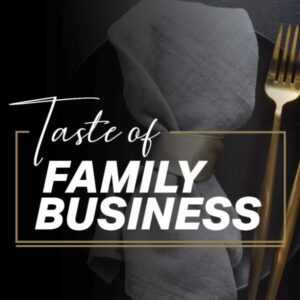Multigenerational ranch, lodge to host family business retreat
Recent News
Over 135 years, E. Ritter and Company has done business in everything from ice and cotton gin to oil and banking. It has owned or operated a saloon, farm equipment company, software business, IT management services, telephone and internet services, and even fire and life safety businesses.
But the consistent elements of the business have remained steady: a commitment to adapt to social and economic change, transition responsibly to new generations and give back.
Based in Arkansas, the company recently connected with the Prairie Family Business Association, even appearing on a recent episode of the association’s podcast, “Family Business Connection.”
“The Ritters have done a phenomenal job at building a culture of cohesion within their Family Council and their family as a whole, as well as engaging the next generations in a meaningful way,” said Stephanie Larscheid, executive director of the Prairie Family Business Association.
Founded by Ernest Ritter in 1889 in Marked Tree, Arkansas, “we now are very much in the ‘cousin consortium’ phase of our growth,” said Brittney Ray, a fifth-generation family member who married into the family business and serves as the full-time chair for the Ritter Family Council.
“There are three branches of our family, with about 80 total family members. Nearly 20 are children. Our oldest is 89, our youngest is almost a month old. We’re spread out across the country, occupying 16 different states, which makes coordinating remote meeting times lots of fun!”
And if you think that’s intriguing, wait until you hear the rest of the family business story. We caught up Ray to learn more.
Tell us a bit about your own path into the family business. What’s your current role, and how has your relationship with the business evolved over time?
I joined the Ritter Family Council in August 2020. I stepped into the chair in May 2021, and in May 2023, that role expanded from a 20-hour-a-month stipend position to a full-time position. And that evolved as part of a bigger initiative to provide the family — not the company — with the resources they needed to achieve the things we want to achieve together. The work wasn’t slowing down or lightening up, and we’re only getting larger with every generation. There was a burnout trend on the rise, and it became difficult to give this role the focus and attention it needed alongside my full-time career as a teacher and entering into first-time parenthood. The expansion of my role to full-time aligned with the family’s renewed commitment to building greater engagement. If we wanted to do more together, we needed to put the resources in place.
Ritter family members participate in an end-of-day conclusion activity at the annual family and shareholder meeting in May.
Initially, my role in the enterprise was as an observer. The world of family business was new to me, and I had a lot of questions. My mother-in-law has been very actively engaged in the enterprise and is on the board of directors. She helped answer my endless questions and encouraged me to take that curiosity and apply for a council member role.
My relationship with the business itself hasn’t shifted radically. I am certainly more educated about the performance of our portfolio, but in my role on the Family Council, I do not directly influence the operation of the business. I help build consensus among the family and share perspectives and current family initiatives with the board. I suppose the greatest change in my relationship with the business is my growing knowledge of it and seeing firsthand how the broader family’s voice impacts the board.
How would you describe the governance structure of your business – and how has that evolved in recent years?
Our governance structure has shifted over the past several decades, and here are some highlights:
- The Family Council was formed in 2008 at the same time our board shifted to a majority of independent directors. The Family Council was formed in part to create a dedicated and appropriate space for the family’s voices to be heard and to keep the family connected.
- Our Family Council is comprised of four at-large voting members, one voting representative for each of our three branches, and right now we have one nonvoting family member — for eight total members. Within our family governance structure, we also have an owners’ committee and a philanthropy committee. We also use task forces ad hoc. We have four family directors on our board.
- Something unique to us is that we also have a part-time executive family coordinator. She is a unicorn. Her role is to support cross-committee collaboration, track meeting minutes and action items, schedule meetings, send agendas, coordinate in-person meeting details with vendors and pull content for our monthly family communication. Aside from the administrative support she provides, she also acts as a sounding board for strategic initiatives in development, and she’s amazing at data analysis too. I’m so grateful to work closely with her. We’ve made numerous changes to professionalize our governance structure, and bringing her on board was one of the best things we’ve done.
- My advice to anyone navigating family council composition is to set your family leaders up for success. Value their time and talents. Serving the family in a leadership capacity as a chair or committee member is incredibly nuanced. Choose the right people for the right roles, build terms for continuity and diversity, and incentivize folks to be in the room.
How do you utilize your family council and what have you found are the key benefits of that?
Our Family Council’s primary jobs are to build family unity and develop family talent. Our Family Council is responsible for making these things come to life, which are ongoing — we never check the box and say, “Phew. We trust each other. Moving on!”
Ritter family summit, Thompson Island, Boston, July 2022
We’ve had to build that trust and work to maintain it, repair it, rebuild it again. In a 135-year history, there’s going to be conflict and tension. The Family Council helps to usher the family through those moments, sometimes even bringing those moments forward, which can be uncomfortable. It also includes anticipating conflict — forecasting it, if you will. You’ve got to look ahead and note the speed bumps in the distance. There’s a lot of strategic planning that needs to take place to keep the family together. Our Family Council makes the decisions related to hosting two in-person meetings a year, prioritizing conversations for socialization among the family and figuring out how to educate the family on different topics. We send folks to conferences, arrange opportunities to build communication skills, highlight unique contributions to the enterprise and, most importantly, foster a sense of belonging within the family. The benefits are plentiful, but I’ll pick two to focus on:
- You have a diverse group of individuals who trust each other and want to stay in business together.
- You have individuals who are equipped and empowered to contribute to the enterprise.
You also married into the family business, giving you a unique perspective on it and making it especially noteworthy you now serve in a leadership role. What advice would you give to other “married-ins” hoping to become involved in the family business?
The inclusion of married-ins varies per family. The Ritters are very welcoming of married-ins. We called them “outlaws” instead of “in-laws” because outlaws are “wanted.” Honestly, married-ins bring a lot of talent and positive energy, and we need them to help keep our family governance forums staffed up!
Erik Kesting, fifth-generation family member and CEO of E. Ritter and Company, gives updates on the portfolio at the annual family and shareholder meeting in May 2022.
I would suggest married-ins listen carefully, ask thoughtful questions and make genuine connections with your extended family members. Throw your name in the ring for opportunities that are a good fit. And hopefully, the family has some sort of onboarding process to help orient new married-ins to the family enterprise. This might include sharing the history of the family and the company, adding married-ins to appropriate family-wide communication and providing them a family tree — this is a great job for the Family Council to be responsible for.
How did you connect with Prairie Family Business Association, and what have your impressions been of the organization? Do you see yourself becoming further involved with the association?
Being the chair of the Family Council can feel a little bit like working in a silo. I couldn’t Google a particular challenge and find out how other family councils were tackling those issues, so I began to search for a peer group. PFBA showed up in my search. After talking with Stephanie Larscheid and attending some of the webinars, I joined PFBA as a member. I’ve really appreciated the connections I’ve made so far, and I feel very passionate about building effective family governance, so I love talking with others navigating the same things. I look forward to more opportunities for those types of interactions.
Philanthropy clearly is a core value of your business. How does your governance structure help guide your approach to it?
The Ritter family cares very much about giving back to the communities that are served by the company’s businesses. The philanthropy committee is a subcommittee of our Family Council, so they adhere to our policies and procedures, but they have their own operating manual. They set their pillars of focus in our philanthropy work, approve grantees and brainstorm meaningful ways to execute their own strategic plan. Their grant work is funded through our endowment fund, and their committee work — meeting materials, marketing/mailing materials, travel, service activity costs, etc., are funded through the Family Council’s budget. Our committee chairs — philanthropy committee, owners committee and Family Council — comprise what we call our leadership team, and the three of us have a monthly call to share updates and collaborate on initiatives that impact our shared or related goals. In this way, the Family Council can provide resources — specific funding, brainpower, agenda time at family meetings — to further support the work of the philanthropy committee.
Ritter family members learn together to strengthen communication skills at a Ritter retreat in Atlanta, November 2023.
Family businesses continue to transition and adjust throughout generations, so how is your business continuing to refine its approach and look toward the future?
If family businesses are lucky, they get to navigate those generational transitions. It means there’s something there to pass on. Right now, we’re having family conversations that are focused on legacy. How do we define our legacy? How do we want to be remembered? Who is our legacy for? Where do profit and purpose fit into our legacy? Understanding the family’s perspectives around this topic will help guide our governance forums to make more strategic — and bold — decisions. We are also spending a lot of time considering family education and, in particular, 6G education to help foster mature, confident, thoughtful, future owners.
Is there anything else you’d like family businesses to know?
I suppose I just want to suggest to the family governance skeptics out there that a successful family enterprise includes a well-performing business and a unified family group. A unified group doesn’t have to look all kumbaya and unanimous. It means that your family — make sure you put your own definition around that! — is all moving together directionally. You might do things differently than the next person, and that’s OK, but directionally, you want to go to the same place. Family governance builds and maintains that alignment, and your business will be better for it.
P.S. This takes a lot of time. It’s worth it.
Listen to or watch the podcast episode of the Family Business Connection featuring Brittney Ray:
Could your family business benefit from a conversation about the future of your family and your business? Take the first step!
- Call us: 1-605-274-9530
- Email us: fba@usd.edu
- Book a conversation with Peter: Calendly












